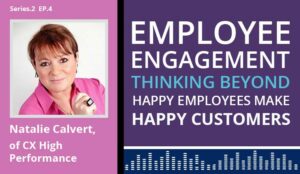Our panel of experts introduce their top tips and tricks for improving the contact centre employee experience.
1. Take a Walk in Their Shoes
This ensures that you’re not only looking at data and metrics, but understanding how happy your workforce is.
Shadow an advisor for the day and get a feel for the role. Understand their daily activities and, crucially, understand the challenges that they, as well as your customers, face.
Advisors are likely papering over the cracks in your process, taking the flack for a poor product, delivery and marketing mistakes or masking that they are dealing with six different systems on every call. This experience alone will reprioritize what’s important within your organization.
Just think about it like this: if you want to grow, you have to fix these issues before the cracks really start to appear. It will be an enlightening experience.

Ben Booth
Once you’ve experienced a day in the life of an advisor, you’ll be able to start to think and ask them what will improve their experience. It could be something as simple as a daily debrief that could make all of the difference in the world.
Then, encourage managers to use data and insight to understand advisor performance and what made them feel good and bad throughout the day. This ensures that you’re not only looking at data and metrics, but understanding how happy your workforce is.
Thanks to Ben Booth at MaxContact
2. Create Online Social Spaces
If well managed, platforms like Yammer are great for bringing people together, sparking engaging conversations between remote advisors and helping people get to know one another.
In our contact centre, we have created Yammer communities, with “pets” and “food” being two particularly popular groups. But that’s far from the end of the story…

Paul Whymark
Team members regularly get together for everything from Macmillan coffee mornings to Friday Fun game show nights. We even have micro-communities such as “Campervan Heaven” and the “Sensée Bake-Off” group.
Creating online spaces like this is important because the social side of any workplace is just as vital as the operational side.
Thanks to Paul Whymark at Sensée
3. Deploy an App for Advisor Scheduling
Connect your WFM solution with an app that advisors can access from their smartphones. This means that your team can easily check their work schedules at any time.
This enables contact centres to perfectly meet the forecast demand, while giving employees the extra control over their schedules that they crave.
For instance, an advisor may need to check their schedule when making plans with family and friends. By going through the app, they can do so quickly and conveniently.
But perhaps the advisor’s schedule appears to scupper their plans? Well, that’s no problem, as the advisor can easily use the app to request a shift-swap or a holiday.
Other employee experience benefits of a WFM app include helpful schedule adherence reminders and advisor preferences.
The WFM can then allocate shifts based on employee preferences and seniority, before leaving the rest up for grabs. This enables contact centres to perfectly meet the forecast demand, while giving employees the extra control over their schedules that they crave.
Personal assistants within your WFM solution can also work well. They provide a personal concierge for self-service, giving recommendations proactively using self-service intraday automation.
4. Establish a Stance Around Diversity and Inclusion
Advisors are becoming more expectant of their managers to make diversity and inclusion a key focus in the contact centre, as well as within the wider organization.
Setting out a stance on this key topic is important. But don’t be scared to go further and create a dedicated plan that includes specifics as to how you will build a diverse and inclusive culture.
To do this, engage with your team and come up with ideas, such as:
- Supporting charities with important social aims
- Celebrating events for underrepresented minorities
- Taking part in social media campaigns

Ed Creasey
Over time, you can then hand this planning over to advisors who demonstrate a keen interest. They will be happy to help establish diversity and inclusion as a key part of your culture.
By doing so, your contact centre will be seen to stand up for important causes and have a purpose that people can connect to. This can help to strengthen advisor engagement.
5. Declutter the Advisor Desktop
Organize employee desktops to include neat tabs for every channel.
A classic advisor frustration is dealing with too much clutter on their desktop. Too often, an advisor will experience complex desktops that include 10–15 applications. This makes important information hard to find.
So, instead of cramming everything onto one screen, organize employee desktops to include neat tabs for every channel.
Another top tip to declutter the desktop is to incorporate screen pops, drop-down menus and a simple search function to make the employee experience as simple as possible.
Yet my biggest piece of advice is to integrate your desktop with other contact centre systems – such as the CRM and knowledge base – so advisors can access all the necessary information to handle customer queries.
The ultimate goal is to get to a place where all of the systems architecture is hidden, so advisors don’t have to open up several different tools but can access everything that they need through their desktop, including the workforce management (WFM) solution.
Thanks to Ed Creasey at Calabrio
6. Tinker With Your Reward and Recognition Schemes
Recognizing your advisors among their peers goes a long way towards increasing their satisfaction.
Using popular pages of your company’s intranet or somewhere similar to give great achievements the attention they deserve.
A system in which advisors are awarded points for a job well done can also work wonders, especially if paired with an online store that offers advisors fun prizes in exchange for the points they’ve earned.

Kristyn Emenecker
A performance management tool can provide such an online store, while also creating a mechanism that facilitates social interaction within the team.
Finally, also use your solution to highlight skill deficiencies that lead to advisor dissatisfaction and build these up to delight customers. It’s a win–win scenario.
Thanks to Kristyn Emenecker at Playvox
7. Get to Know Individual Motivations
Before running off and setting up workshops and trying to fix up an engaging environment, start by asking what your advisors actually want and where they want to be in their future.
Ask your teams questions, such as:
- What are their interests and career objectives?
- Do they have development plans?
- If not, why not?
Then, look into advisor frustrations with their day-to-day experience and start to demonstrate that the issues are being recognized.

Sean McIver
Again, advisors will feel heard and engaged and will probably volunteer their own thoughts and ideas unprompted because there’s a positive endorphin kick associated with that engagement.
Just hearing “That’s a great idea!” is hugely motivating for many people, especially coming from higher tiers of the business.
Thanks to Sean McIver at MaxContact
8. Keep Constant Tabs on Advisor Workload
Actively managing workload should be a high priority for any business that cares for its customers, because happy advisors lead to happy customers.
To unlock the best employee experience, managers can:
- Use accurate data insights to improve both operations and business
- Automate repetitive tasks with easy to set up workflows
- Bring context directly to the advisor panel so they have everything in one place.

Nikhil Shoorji
Also, connect third-party systems. This includes your CRM, ticketing, and/or e-commerce systems, which will give advisors everything they need at their fingertips, rather than having to flip through tabs and screens.
The result? Fast, personalized customer support, leading to improved metrics and ultimately increase advisor satisfaction.
Thanks to Nikhil Shoorji at Infobip
9. Break Down Contact Centre Silos
With the variety of different tools in play, and with rapidly changing processes, it can be challenging for contact centre advisors to get the right answers quickly. This is especially true when changes in the business lead to unexpected customer scenarios.
Also, in a remote environment, it’s easy for advisors to slip through the cracks and for their daily work requirements to be missed.

Chris Marron
By investing in the right tools, businesses can break down silos across the business and ensure a simpler employee experience, as well as a better customer experience.
A failure to address this will culminate in disengaged employees feeling even less motivated to deliver quality customer service.
Thanks to Chris Marron at 8×8
10. Allow Advisors to “Grow Up”
Show advisors that their efforts have a positive impact and that the business values their efforts.
Letting advisors “grow up” may include sharing contact centre data (think queue depth or wait times) that helps them to better self-manage and reduces the need for micro-management.
Recognition can also go a long way, so share business metrics, show advisors that their efforts have a positive impact and that the business values their efforts.
In addition, many advisors – especially seasoned pros – appreciate the opportunity to share their knowledge. Simply listening to that is great for the employee experience, while it can also benefit the contact centre.
A great example is giving advisors the chance to make suggestions for tasks that are good candidates for automation, while also providing valuable feedback for implementation.

Annette Miesbach
Finally, where possible, make sure that advisors are considered when there’s an opportunity for growth.
Of course, not every advisor wants to stay in their role indefinitely, but knowing that there’s potential for growth will boost morale, not to mention retention!
Thanks to Annette Miesbach at NICE CXone
11. Offer Everyday Wins
Helping advisors to experience those everyday wins gives them the motivation needed to succeed, especially in periods of stress and fatigue.

Aviad Abiri
Gamification is a powerful tool for this. Often, organizations actively provide their advisors with moments to “win” through customized quizzes or trivia applications, based on employee personality type.
Not only does this help to put smiles back on faces, through fostering a feeling of success, it also provides all employees with key learning and development opportunities that boost performance.
Thanks to Aviad Abiri at NICE
12. Measure Advisor Sentiment
Many contact centres are already capturing and analysing customer conversations to understand their needs and expectations, and are turning those insights into action.
However, why can’t we take the same approach with employees?
It’s not enough to simply acknowledge that employees are stressed or overworked.

Frank Sherlock
By measuring sentiment, key drivers, and common concerns across the contact centre – just as they would their customers – organizations can take action to improve satisfaction, engagement and retention.
When employee concerns and challenges are used to inform and tailor initiatives that support productivity, employees are more likely to feel involved, engaged and empowered.
Thanks to Frank Sherlock at CallMiner
13. Play a Game
Advisors are dealing with surges in call volumes, complex customer cases and the aspiration to be acknowledged in the work environment. It’s easy to lose morale.
To keep up, many contact centres have turned to gamification, which companies such as Yahoo, LinkedIn and Amazon are also now implementing.
Gamification incorporates fun and competition into the workplace while pushing advisors to perform at the best of their ability.

Alex Stenton-Hibbert
Many workforce management systems now come equipped with a built-in gamification module. These systems reward good advisor performance by awarding gold, silver, and bronze medals.
Such medals – which are based on pre-determined parameters and metrics – can then be traded for prizes, such as being first in line for the next shift.
Thanks to Alex Stenton-Hibbert at Business Systems
14. Bring Remote Advisors Together
The majority of customer interactions are taking place remotely, with many advisors on their own, in their home environment.
Making sure dispersed teams feel connected and supported is really important to create a positive culture, with a motivated and positive team.
Teams have lost the camaraderie, collaboration and social aspect of working together in the same place. This is a key element of alleviating the stress of working in a busy contact centre.
Making sure dispersed teams feel connected and supported is really important to create a positive culture, with a motivated and positive team.

Judith Hogan
To achieve this, extend your use of communication tools so they are not only given out to assist advisors in their customer interactions.
Easy-to-use, pro-grade solutions like webcams, headsets and speakerphones can be used in any workspace and will enable advisors to connect, chat and collaborate with high-quality audio and video throughout their working day.
Thanks to Judith Hogan at Poly
15. Give Your Team the Tools to Succeed
With advisors working longer hours in an isolated environment, burnout is a common side effect and can drastically reduce productivity and engagement within the contact centre.

Peter Milligan
It is therefore important that leaders equip their teams with the right technology to reduce repetitive, busy work that can often leave advisors frustrated.
For example, adopting virtual agents can allow your advisors to focus on the high-value customer interactions that require a human touch and specialist customer care.
Thanks to Peter Milligan at Five9
16. Clean Up Internal Communication
Having to search for information through multiple applications and systems lengthens call times while increasing advisor stress levels.
To alleviate this, businesses can integrate systems to ensure that advisors have everything they need at their fingertips.
Coupled with this, businesses can make collaboration tools, such as Microsoft Teams, available to advisors. These tools will support advisors in including third parties, such as supervisors, experienced advisors, or staff from other business departments. This speeds up difficult conversations.
Moreover, by providing technology that allows advisors to connect in real time to knowledge-management stores, organizations can ensure they always have access to a single source of information. This enables advisors to do their job with confidence.
17. Step Up Coaching and Support
By monitoring calls, flagging areas where the language is not compliant and giving prompts when needed, speech analytics guides advisors through each interaction, ensuring that nothing is missed.
The technology also provides key support and reassurance in the event of a dispute, while offering automated quality assurance and call optimization for every call.

Jeremy Payne
To further enhance the employee experience, use the solution to analyse advisor and customer speech.
This includes stress levels and script adherence, while delivering automatic live feedback to advisors and team leaders, helping to improve conversations in real time.
Thanks to Jeremy Payne at Enghouse Interactive
18. Increase Team Visibility
Empowering agents both internally and externally starts with visibility. By promoting a shared purpose and vision, we can empower employees to perform better.
Especially with continued offsite work and new company dynamics, it can be helpful for a manager to look for new and different ways to increase individual and team visibility.
Rewarding a team with increased responsibility or the opportunity to head up a company-wide initiative may send the right message that teamwork does indeed make the dream work.
The chance to lead within teams or tasks will also let you evaluate individual strengths and could provide valuable insight that would otherwise prove difficult to gather.
Observation of team dynamics can often give you the most complete picture of an employee and a team’s overall health and resiliency. It’s also an opportunity for junior team members to contribute under the tutelage of senior agents while the team learns to trust the process and each other.
19. Keep your People Engaged From Day 1
The process of onboarding has undergone massive changes in the last 18 months. Many companies have enjoyed the opportunity to streamline the process while giving new hires the opportunity to actually hit the ground running.
Process, competency, service quality, and customer satisfaction all suffer when there is a lack of experienced staff.
It’s quite reasonable to expect new talent to do the pre-work, read the wiki, and be prepared for on-the-job training as soon as they’re cleared from HR.
We’ve talked a lot about onboarding, and for good reason. One of the biggest obstacles to team, company, mission, and vision is churn. Process, competency, service quality, and customer satisfaction all suffer when there is a lack of experienced staff.

Philip Stanfield
Everyone suffers when the collective knowledge and learned experience within teams goes missing.
Prioritize employee engagement from the start by stressing the availability and inherent value in people, process and technology.
Thanks to Philip Stanfield at Alvaria
Discover lots more great ideas, courtesy of our panel of experts, for enhancing the employee experience, within our articles:
- 11 Team Engagement Ideas to Inspire Your Remote Workers
- Dealing With COVID-Fatigue in the Contact Centre
- How Can I Improve the Productivity of Gen Z and Millennial Advisors?
Author: Robyn Coppell
Published On: 14th Jun 2021 - Last modified: 6th Sep 2024
Read more about - Call Centre Management, 8x8, Alex Stenton-Hibbert, Alvaria, Annette Miesbach, Aviad Abiri, Ben Booth, Business Systems, Calabrio, CallMiner, Ed Creasey, Editor's Picks, Enghouse Interactive, Five9, Frank Sherlock, Infobip, Jeremy Payne, Kristyn Emenecker, MaxContact, NICE, NICE CXone, Nikhil Shoorji, Playvox, Poly, Sensee








































